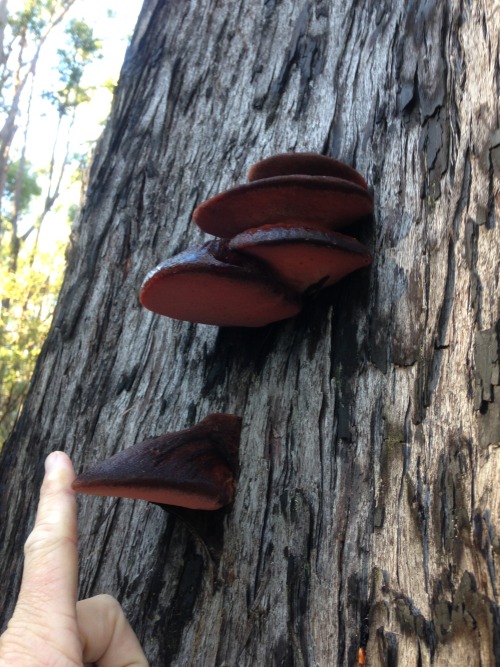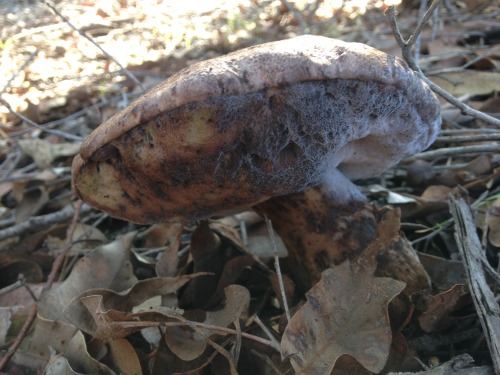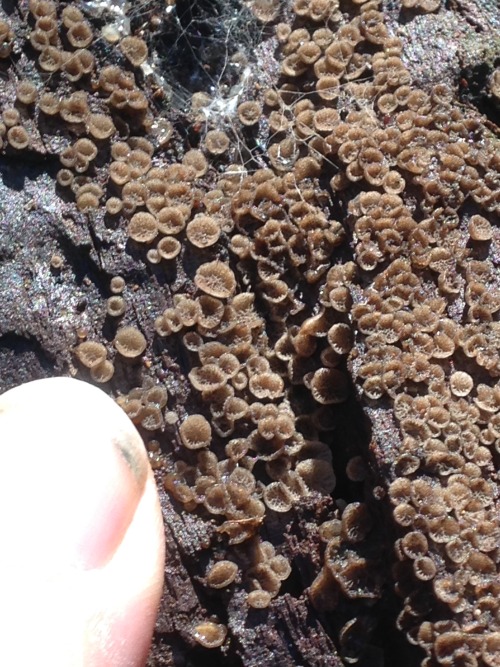#1657-1663
#1657 - Boletellus obscurecoccineus - Rhubarb and Custard Bolete



With the COVID19 restrictions finally relaxed here in western Australia, we had our first field trip with the WA Naturalist’s Club in months, out to the forest near Dwellingup SE of Perth. I invited members of the WA Insect Studies Society along too, and it appears they were going stir crazy too, since we ended up with over 30 people searching the undergrowth.
One of the many fungi we found was this bolete, a species found in Australia, New Guinea, Borneo, Japan, Korea, Taiwan and Java (from where it was originally described). The flesh is yellow, and bruises blue in most parts of the range, but not in WA, oddly.
A number of Asian species have been synonymised with this one, but a similar species from Africa turned out to be distinct enough to get their own name. Elsewhere in the world the species in ectomycorrhizal with oaks and other decidous species, but in Australia it’s associated with eucalypts.
Edibility is unknown, despite the common name.
#1658 - Fistulina sp. - Beefsteak Polypore


Named for the resemblance to a slab of fresh meat, and indeed it’s quite edible, if collected young, although the taste is somewhat acidic and it may require long cooking. Also known as the ox tongue, or tongue mushroom.
Althought that all assumes it’s Fistulina hepatica (although Hepatica itself refers to the resemblance to liver) - it could just as easily be Fistulina spiculifer. There seems to be an ongoing argument about whether you can tell you two apart without examining the spores under a microscope, which species of tree they grow on, and which species we actually get in Australia.
Assuming they’re close enough that we can discuss them as the same species, they’re quite widespread in Australia, North America, Africa and Europe. In the northern hemisphere F. hepatica is common on oaks and sweet chestnut, and the brown stain it imparts to oak makes for a valuable timber, as long as the Brown Rot it imparts by dissolving the cellulose with hydrogen peroxide isn’t too advanced. In Australia, it grows from wounds on Eucalypts, and the timber develops long dark streaks.
#1659 & 1660 - Gyroporus aff. cyanescens & Hypomyces chrysospermus - Variable Gyroporus & Bolete Eater


Another fungus from up at Dwellingup - in fact, two fungi. It’s a large bolete being parasitised by a ascomycete.
Gyroporus is a small genus of bolete, with brittle stems with hollow cavities in the mature stem, and yellow spores. The colour they change when cut is an important diagnostic feature when IDing them. In G. cyanescens, the flesh turns blue when cut, but in this one it turns a deep violet, so it’s almost certainly not the same species despite being nearly identical in other respects. The real G. canescens is found in Eurasia, the eastern US, and apparently here in Australia too, but it’s entirely likely that many of the latter are imposters.
This one was growing under a tree next to pasture, in shallow leaf litter, but it’s also found in sandy and grassy areas.
The Bolete Eater, on the other hand, is found in North America, eastern China, and Europe, where it is common, and here in southwest of Western Australia. A slightly odd distribution, and may indicate that it was introduced by people, but it’s far from the only species of fungus that widely scattered.
The fungus spreads out over the pores of the infected bolete, and eventually the rest of the mushroom, forming a continous white crust that turns yellow and then reddish brown as it matures.
Other fungi in the same genus target other kinds of mushroom - H. lactifluorum, the Lobster Mushroom, for example, attacks gilled mushrooms in the family Russulaceae. Fungi thus infected turn the orange-red of a cooked lobster, and actually do have a seafood-like flavour. Eating them is still potentially unwise, since the host fungus could easily be poisonous in its own right. Hypomyces chrysospermus, on the other hand, is flat-out inedible, and may be actively poisonous.
#1661 - Ramaria ochraceosalmonicolor - Pink Coral Fungus


These ones were sprouting all over the place up at Dwellingup - nice to see, since I haven’t seen a coral fungus since I left Sydney.
A species from the Gomphaceae family, widespread in Australia, but many of the species in the genus are difficult to tell apart. Some species in the genus are mycorrhizal, and some grow on on buried timber, and it’s possible that some species do both.
Edibility of the coral fungi is debatable - most references in English say they’re bitter, and inedible, which is odd since in most other parts of the world they’re enthuiastically collected for food. That may be because of the number of lookalike species, or because the English are notoriously fungiphobic. In the case of this species, it’s been reported as edible, but is suspiciously similar to Ramaria flavo-brunnescens, that grows exclusively under Eucalyptus in Brazil and other places in South America, and has been responsible for some horrifying cattle deaths over there.
But it’s not like ‘edible’ mushrooms haven’t killed anybody, let alone ones with conflicting reputations like Ramaria.
#1662 - Phellodon niger - Black Tooth Fungus

Wikipedia says this species is found in Europe and North America, and that the North American species is probably distinct, but doesn’t mention that it’s also widespread in the SW and eastern parts of Australia. There are certainly multiple cryptic species in the UK, based on DNA testing, so the Australian species will probably turn out to be Phellodon aff. niger until somebody redescribes it properly.
From above it looks like an unusually dark Coltrichia with pale edges, but if I’d looked underneath I would have seen it is covered in pale grey teeth instead of pores.
Tough, and inedible, but can be used to produce a blue-grey or green dye.
#1663 - Campanella gregaria - Gregarious Shells


An intriguing little mushroom that grows abundantly on the underside of rotting Banksia, Casuarina and Eucalyptus wood and bark.
The fruiting bodies are brown or grey, and rubbery, with radial ribs and a honeycomb of other partitions between those ribs.
There’s some 40 species of Campanella, mostly tropical, and a good range in the eastern parts of Australia, but C. gregaria seems most closely related to the NE Asian Campanella boninensis. But there is a second Campanella sp. in WA that has yet to be described. There’s also a genus of ciliates called Campanella, which is simply annoying.